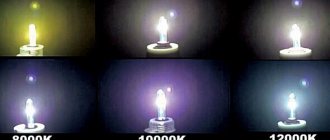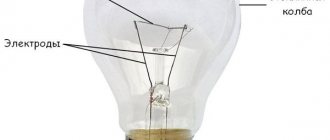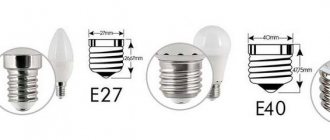What is a dimmer and what is it used for?
Spotlight with dimmer
A dimmer (from English “to darken”) is a device that regulates the power of a lamp by controlling the incoming voltage. It is most often used for incandescent and LED lamps.
The light regulator (dimmer) for incandescent lamps was invented a long time ago. The first such device was a simple rheostat, which adjusted the brightness of the light source by changing its resistance. Later, electronic dimmers were invented - convenient and small. With their help, you can not only control the intensity of light in the room. The list of useful options controlled by the dimmer is much longer:
- save energy and family budget;
- imitation of residents in an apartment (in case of long-term absence of owners);
- remote control using modern gadgets or sound signals;
- automatic switching off and switching on of lighting;
- create different interesting lighting modes (for example, blinking).
Is the incandescent dimmer suitable for LED bulbs?
First you need to understand how the brightness of incandescent lamps and LEDs is adjusted.
The brightness of incandescent lamps can be adjusted by changing the voltage. For example LATR.
Or by cutting off part of the half-wave of the mains voltage. A triac copes well with this function. Using a variable resistor, the user controls the moment the triac is turned on relative to the transition of the mains voltage through zero.
The sooner the triac turns on after the voltage crosses zero, the greater the average voltage value will be supplied to the lamp filament and the brighter it will light up.
The later the triac turns on after the voltage passes through zero, the lower the average voltage value will be supplied to the filament and, therefore, it will glow with less intensity until it goes out completely.
Mains voltage oscillogram.
It shows here that the triac turns on after 5 milliseconds have passed after the voltage crosses zero. Those. in the middle of each half-cycle.
The following picture shows that the triac turns on somewhere closer to the end of the half-cycle. Here the brightness of the lamp is already closer to the minimum.
The brightness of the LED is adjusted by changing the current passing through it. The voltage on the LED itself remains unchanged.
Question: Can the brightness of an LED lamp be adjusted using a dimmer for incandescent lamps?
Answer: In two cases it is possible.
1 case. If the lamp says that it is dimmable. It can be turned on via a dimmer for incandescent lamps. Since this lamp is powered using a so-called dimmable driver. For example, a chip such as LM3445 is this dimmable driver. The change in brightness here occurs due to a change in the width of the pulses that power the LEDs of the lamp. The smaller the width of the pulses and the longer the pause between them, the lower the average current passing through the LEDs and, therefore, the lower their brightness. This is the well-known PWM. The microcircuit monitors the average voltage value, which we regulate with a dimmer and, in accordance with its value, changes the width of the pulses at its output.
Almost maximum brightness.
Almost minimal brightness.
Case 2. If the power supply circuit for the LEDs in the lamp is made according to the simplest and cheapest circuit based on a quenching capacitor.
Like that.
There is no current stabilization here. Therefore, lamps with such a power supply will change their brightness when using a dimmer for incandescent lamps. By the way, the stability of the current is an indispensable condition for the durability of LED lamps.
If, however, the power supply circuit of an LED lamp is made on a non-dimmable microcircuit, then it will not be possible to change its brightness using a conventional dimmer. Since such a microcircuit maintains a stable output current when the supply voltage changes. An example of such a driver chip is the widely used BP2831 and BP2832 microcircuits.
The circuit on these microcircuits.
So we gallop across Europe about adjusting the brightness.
Dimmer classification
Dimmer design options
Depending on the control method, the following devices are distinguished:
- With mechanical regulation. The easiest and most affordable way. Light control is carried out using buttons. Next, the signal is transmitted to the controller, which is built into the electrical network. Often built into a regular switch. However, now such a device is considered obsolete. It was replaced by new devices.
- With electronic regulation. The power control mechanism is similar to mechanical. But instead of buttons, a modern sensor is used. A display that reflects the necessary information makes electronic regulation more informative, fashionable and expensive.
- With acoustic regulation. Light control is triggered by an audible signal. It could be a voice or a clap. The signal volume level is set by the manufacturer or user. However, there are some restrictions. Firstly, a small number of user modes. Secondly, the acoustic sensor will respond to any sound of the desired volume, which will create inconvenience during use.
- With remote control. glow is controlled using wireless devices. This role can be played by smartphones, remote controls, and tablets. The control device can use a radio communication channel, infrared or wi-fi. The option using radio communication is effective and reliable. You can also give commands from outside the room. But the necessary equipment is quite expensive, which limits the applications of this communication channel.
The infrared remote control is cheaper, so it is more in demand. However, you can reduce the brightness only by pointing the remote control at the dimmer. This somewhat limits the range of use of the remote control.
Control via wi-fi occurs using tablets and phones. It allows you to program a dimmer to automatically turn on/off the light, simulate the presence of residents, and others. Optimization of energy consumption is possible. True, such management is not cheap.
According to the installation method there are:
- Surface-mounted dimmers that are mounted instead of a switch. This is the simplest, most affordable and popular option.
- Built-in regulators are mounted in a special compartment of the electrical distribution box.
- Modular (panel) ones are built directly into the electrical panel. The most expensive way. Rarely used for domestic premises.
Classification of stepless switches by parameters
Various parameters are used to classify dimmers, including installation location and control method.
At the installation location
Dimmers are:
- overhead (monoblock);
- with hidden installation (box or instrument).
- DIN rail mounted (modular).
The monoblock dimmer is installed in the same way as traditional switches. The electronic mechanism is located in the housing; on the outside there are terminals for connecting to the network, a handle or a key.
Boxed models are small, round or rectangular, with terminals for connecting to the network. The installation socket is the same as for the switch. If the room has a partition or false wall made of plasterboard, the box can be installed without a mounting box out of reach and the lighting intensity can be changed using the remote control.
Modular devices are installed in distribution boards. Control is carried out with a regular key or remote button.
They are rarely used for residential premises. The main area of application is corridors and stairs.
According to control principle
For control are used:
- handles, swivel wheels, keys;
- touch systems with buttons or screen;
- sound signals;
- remote controls;
- wi-fi (via tablets or smartphones).
The simplest mechanical infinitely variable switches
Most often, devices are installed with a mechanical type brightness control - a knob. It rotates clockwise and counterclockwise. A more convenient option is turning in combination with pressing (to turn on/off). Keyboard models may have multiple keys. The choice depends on the number of lamps in the luminaire and the method of connecting them.
Many consider these dimmers to be the most reliable due to the lack of complex electronics. Switching on/off occurs in the specified mode (no need to rebuild each time). These are effective and simple devices that are affordable for most. The only drawback is lack of prestige.
Touch control of stepless controller
Touch dimming is carried out when there are various sensors in the system. To change the light intensity, you need to touch the screen or button and hold your finger until the required value is reached. The functionality is wider due to the presence of a timer in the system, which allows you to program the device yourself.
Advantages of a touch dimmer:
- high reliability;
- presence of night mode (not available on all models);
- the ability to combine with any interior;
- splash resistance;
- no need to change wiring when connecting;
- You can connect yourself.
Acoustic models turn on when there is a sound in the room (clap, voice) exceeding the noise level determined by the user. These dimmers are convenient, but the number of modes is limited and they cannot be changed. The sensor can react to any noise, so it is difficult to control the situation.
Attention! Due to the high cost, this equipment is purchased mainly to surprise guests.
Dimmers with remote control some features
For remote control, infrared or radio waves are used. This type of dimmer for LED lamps consists of a remote control and a signal receiver. The functionality is wide, right down to blinking the lights to the music. Models with infrared rays are more affordable.
Dimmable LED lamps and types of dimmers for them
Dimmable LED light source.
Dimmable LED lamps operating on 220 V AC voltage
Unfortunately, not all LED lamps are dimmable. A light source not intended for this purpose will not change brightness. This occurs due to the fact that the LED element contains a driver in its design. Its task is to convert alternating voltage into direct voltage and maintain the stability of electrical characteristics. And for any deviation from the required voltage parameters, the driver will still adjust them to optimal values. Attempting to reduce the brightness will result in blinking or damage to the lamp.
It is best to choose special dimmable lamps. Their driver design includes an additional circuit that ensures the LEDs operate when the brightness decreases or increases. They are more expensive, but will work properly.
To find out whether a particular lamp is compatible with a dimmer, just look at the packaging. Most often, the manufacturer writes the word dimmable or the item “brightness adjustment possible.” There is also a graphic image: a special icon.
When choosing a light source, it will be useful to consult a competent sales consultant.
LED lamps require a special dimmer. The 220V LED dimmer does more than just reduce the voltage. It uses a rather complex pole-width modulation mechanism. As a result, the current is supplied in short pulses with long pauses. This modulation is repeated up to a hundred times per second.
There are two types of regulators that use this mechanism. The first type is simpler and cheaper. leading edge cutoff dimmer .
Voltage characteristic with leading edge cutoff.
Dimmers of this type are compatible only with dimmable LED lamps. The manufacturer initially included this function in them.
In addition, due to the nature of the pulse curve, interference is created in the electrical network that will interfere with the operation of household appliances (TV, etc.). Dimmers of the second type - with cutoff at the trailing edge - do not have this drawback.
Voltage characteristic with falling edge cut-off
Even non-dimmable lamps work with such a dimmer, but only within a certain brightness range. Only special dimmable LED light sources can be turned off to zero.
A dimmer that operates with trailing edge cutoff is more versatile and more expensive.
Dimmable LED lamps operating at constant voltage
In addition to LED lamps operating on an alternating voltage of 220 V, light sources are produced that use a constant voltage: 4 and 12 V. 4-volt lamps are used mainly as indicators and rarely require adjustment. But 12-volt light sources are often used to implement spot decorative lighting in cars or LED strips. Such lamps are controlled by simpler devices.
Dimmers regulating 12 V lamps
Dimmer for LED strip
Light control of light sources with a voltage of 12 Volts DC is carried out using a controller with pulse width modulation (PWM) . The 12 V dimmer smoothly changes the voltage supplied to the LED strip. It does not affect the amplitude of the current.
Characteristics of pulse width modulation
Dimmer for three-color LED strips (red-green-blue) have three control channels. This way you can adjust the brightness of each color separately. You can also change the speed at which colors change.
How does a dimmer work?
How to Install LED Ceiling Lights
Dimming is carried out using “phase cut-off”, in which one part of the sinusoidal voltage in the network is cut off, and the effect that supplies the voltage to the lighting is reduced. If the cutoff action is applied at the beginning of the sine wave, the technique is called “rising edge dimming”; if the technique is applied at the end of the sine wave, the technique is called “falling edge dimming.”
These methods are used to dim different types of lamps: “Falling edge dimming” is recommended for low voltage LED or halogen lamps using electronic transformers. "Leading edge dimming" is used for low voltage lamps using electromagnetic type transformers, as well as for 230V compact fluorescent and LED lamps. These two methods are also well suited for halogen lamps and 230V incandescent lamps.
Choosing a dimmer for LED light bulbs
High-quality selection of dimming for LED lamps
Before choosing an LED dimmer, you must clearly understand which light sources need to be adjusted. For 220V AC lamps, phase-pulse devices with trailing edge cut-off are best suited. For low-voltage 12 V light sources, any PWM controller will do. In addition, it is worth buying quality lamps.
Next, you should arm yourself with a calculator and start calculating the required performance of the LED controller. To do this, you need to add up the power of all the lamps whose brightness you plan to control. If you buy a lower power dimmer, it will break very quickly. Experts advise multiplying the resulting amount by 1.2, or better yet, by 1.5. This creates a safety margin for the dimmer, increases service life and makes it possible to connect additional light bulbs. For example, for lamps with a total power of 80 W, a regulating device should be chosen with a power of 100 W, or better yet, 120 W.
But it is worth considering that dimmers for controlling several lamps are designed for a minimum power of 25-40 W. If the sum of the powers of your light bulbs is less, then you should install your own dimmer for each lamp.
After choosing the type of dimmer, you should decide which control method is right for you: mechanical or remote. The main criterion here is the cost of the devices.
It is worth choosing a device that can provide minimum brightness. Such a control device makes it possible to make maximum use of the control possibilities.
The above-described qualities are satisfied by products from well-known global manufacturers. LED lamps from Philips, Osram, Gauss work stably and for a long time. Legrand and Schneider are the leaders among dimmer manufacturers. You should not save money and buy products from little-known companies - there is a high probability of throwing money away.
Unfortunately, there is a possibility of incompatibility between lamps and dimmers. In this case, the dimmer does not work. The reasons are related to different principles of supplying electrical characteristics. For example, a dimmer uses a mechanism with cut-off on the trailing edge, and a lamp uses a cutting-off mechanism on the leading edge.
Often, compatibility can only be verified experimentally. Experts advise first installing a light control system, and then selecting light bulbs for it. In this case, it is worth asking about the possibility of returning and replacing an unsuitable light source. Using lamps from well-known brands and consulting a competent seller reduces the likelihood of incompatibility.
Types of dimmers
First of all, let's look at dimmers based on how they control lighting. The most common is a device with a mechanical control type. Here, buttons or a wheel are used as a brightness control. Gradually rotating this wheel achieves the required brightness; when rotating all the way in the opposite direction, the lighting in the room is completely turned off. If buttons are used as a regulator, then such a dimmer is similar to a regular switch with two buttons. In this case, one is responsible for turning the lighting on and off, and the second regulates the brightness. There is also an option with touch controls. Such dimmers fit into any interior and are now gaining great popularity. These models have touch buttons in the form of “+” and “-” signs, with their help the required brightness is selected. There are also options with remote control, which for many are the most convenient option. After all, you can carry out any manipulations with light from anywhere in the room. Such models can operate via an infrared channel or a radio channel. In the first case, you need to point the remote control at the device, and the second option allows you to perform manipulations even from the street.
Devices can be divided according to installation method. Dimmers that are installed like regular switches are called overhead dimmers. To install them, you do not need to drill additional holes; they are simply attached to the wall.
There are also built-in options; here you need to make an additional niche where the dimmer will be installed.
There are also modular devices that are installed on a DIN rail. Such devices are mostly used in entrances, but they are expensive, so they are not very widespread.
Do dimmers save energy?
When using high-quality LED lamps and LED regulators, yes. True, not right away. But in the future, savings are possible on the following points:
- Reducing energy consumption by approximately 20-30%. This happens due to a decrease in the power of the light bulbs at moments that do not require full brightness of the light. For example, while watching TV, working at the computer, when children are sleeping, etc.
- Operating in low brightness mode significantly increases the service life of LED lamps. LED lamps, in principle, have the highest operating capacity (15,000-50,000 hours). The question of replacing light sources will not arise before you for many years. This means you won’t have to spend money on light bulbs for a long time.
Don't expect the costs to be recouped instantly. According to experts, it takes at least two years to begin to benefit from the installation of a dimming system.
It is also worth considering that most of the electricity in the house is usually consumed by household electrical appliances. Their power cannot be reduced.
How to connect a dimmer to LED lamps?
At the beginning of work, you should focus on the standard connection diagram, so that in the end the phase ends up behind the regulator. The wire from the output contact is directed towards the lamp. Connecting a dimmer to an LED lamp has certain features:
- It is prohibited to connect lighting devices of different types to one regulator, for example, LED and incandescent.
- Check that the contacts are connected correctly so that the lamps do not flicker or burn out.
- A dimmer for LED lamps cannot be connected to a large number of devices at the same time, so there should be a maximum of ten of them.
- All lamps used must be of the same type and power.
Average cost of dimmers on store shelves
The cost of the control device depends on many parameters. Among them: the popularity of the manufacturer’s brand, power, quality, control method (touch controls are more expensive than mechanical ones, and contactless ones are the most expensive), appearance, etc.
The French Legrand produces dimmers with power from 300 to 1000 W. They are compatible with lamps that operate on both AC and DC voltage. Prices start from 1400 rubles for a 12V dimmer. Dimmers 220 V with mechanical control cost from 1900 rubles.
Dimmers from German Schneider are even more expensive: the cost of a mechanical regulator for 220V starts from 3,000 rubles.
However, at approximately the same prices you can find touch devices from less popular companies. For example, Wemmon's prices start at 2,200 rubles. The Broadlink company offers touch-sensitive dimmers starting from 3,000 rubles.
The Italian manufacturer Donolux offers a contactless dimmer with a coverage radius of 30 m at a price of 3,100 rubles.
It makes sense to carefully study the offers on the market in order to choose quality devices at a good price.
Things to consider when purchasing a dimmer:
Which lamps are suitable for dimmer?
There are different models of dimmers, as well as load types, which makes it necessary to select the appropriate device. The dimmer is selected depending on the type of load. This means: what kind of lamps are used, are they used through a transformer or does the lamp work normally from a 220 V power source? This information can be found on the manufacturer's packaging, as well as on the lamp itself. If you are unsure how a dimmer works with a particular lamp, ask an electrician or seller. There are many different dimmable light sources on the market that require special dimming devices. But in general, they can be classified according to their technology.
The most popular and common dimmer lamps are listed below:
How to make a simple dimmer yourself
Simple dimmer yourself
If you understand electrical engineering, love and know how to solder, then you can try to make a simple dimmer with your own hands.
To work independently with electrical appliances, you must have minimal knowledge of electrical engineering. It wouldn’t hurt to get a first or second and an electrical safety group. Your safety depends on it.
To do this you will need:
- two resistors: constant with a resistance of 10 kOhm and variable 470-500 kOhm;
- capacitor with a capacity of 0.1-0.22 μF;
- triac VTA 17600;
- dinistor
Electrical circuit of the simplest dimmer: TRIAC - triac, DIAC - dinistor, C1 - capacitor, R1 - constant resistor, VR1 - variable resistor.
The main working element in the circuit is a triac. The power of the resulting dimmer depends on it. For VTA 17600, the dimmer power will be up to 1 kW. You need to connect a simple mechanical regulator to it, which will control the brightness of the light bulb.
You can mount elements on a printed circuit board using a hinged method or a soldering iron.
Confidence-inspiring dimmable LED lamps
1.Uniel E27 dimmable LED-A60-11W/NW/FR/DIM
Uniel LED lamp
| General characteristics | |
| Lamp type | LED |
| Flask color | Matte |
| Flask shape | Pear |
| Power | 11 W |
| Voltage | 175-250 V |
| Light | Warm shade |
| Dust and moisture protection | IP20 |
| Colorful temperature | 3000 K |
| Light flow | 902 lm |
| Color rendering index (Ra) | 80 |
| Dimming | Eat |
| Length | 112 mm |
| Diameter | 60 mm |
| Life time | 30000 h |
| Brand country | Russia |
| Note: Good competitor to foreign models | |
2. LED lamp gauss 102502111-D, E27, A60, 11W
Gauss LED lamp
| General characteristics | |
| Lamp type | LED |
| Flask color | Matte |
| Flask shape | Ball |
| Power | 11 W |
| Voltage | 150-265 V |
| Light | Warm shade |
| Dust and moisture protection | IP20 |
| Colorful temperature | 3000 K |
| Light flow | 960 lm |
| Color rendering index (Ra) | 90 |
| Dimming | Eat |
| Length | 110 mm |
| Diameter | 60 mm |
| Life time | 35000 h |
3. LED lamp Osram PARATHOM CLASSIC A 75 11W 2700K
Osram LED filament lamp
| General characteristics | |
| Lamp type | LED |
| Flask color | Matte |
| Flask shape | Pear |
| Power | 11 W |
| Voltage | 165-230 V |
| Light | Warm shade |
| Dust and moisture protection | IP20 |
| Colorful temperature | 2700 K |
| Light flow | 1055 lm |
| Dimming | Eat |
| Length | 110 mm |
| Diameter | 60 mm |
| Life time | 25000 h |
4. LED lamp Philips 929001209327
Philips LED lamp 6.5 W
| General characteristics | |
| Lamp type | LED |
| Flask color | White |
| Flask shape | Pear |
| Power | 6.5 W |
| Voltage | 150-225 V |
| Light | Warm shade |
| Dust and moisture protection | IP20 |
| Colorful temperature | 3000 K |
| Light flow | 600 lm |
| Color rendering index (Ra) | 80 |
| Dimming | Eat |
| Length | 169 mm |
| Diameter | 52 mm |
| Life time | 15000 h |
| Model warranty | 2 years |
Conclusions: advantages and disadvantages
pros
- Reduced energy costs.
- Increased service life of LED light bulbs.
- Simulating the presence of the owners when the apartment is empty.
- Fashionable ways to decorate an apartment.
- Integration into the “smart home” system.
Minuses
- High price. High-quality models, especially touch and non-contact ones, are expensive.
- Models operating on the leading edge cut-off principle interfere with the operation of household appliances.
- You should carefully select LED lamps and dimmers for each other, otherwise the equipment will not work as it should or will simply break.
- The dimmer will break if the manufacturer's recommendations for power characteristics are not followed.
A dimmer is not an essential item. However, it is convenient, fashionable and provides significant opportunities for design and some savings.
- Related Posts
- All about SMD LEDs (parameters, testing and soldering)
- Types of lamps with g4 socket, comparison, popular manufacturers and models, selection of drivers for g4 12V lamps
- What is a base and lamps need one for it











